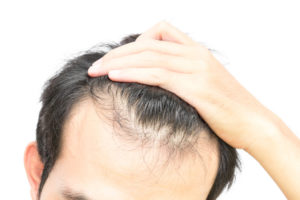

Hair Loss and Growth
It is no secret that hair loss can induce great anxiety, low self-esteem, avoidance of social events and worst of it all – feeling older and less attractive. It is a fact that by the time we are born, the human body stops producing new hair follicles. As the body ages, hair follicles weaken and in many cases, stop making hair altogether. Thus, the hair loses that sultry volume, thins out and excessively sheds. Hairstyling becomes way more complicated due to widening parts – a bad hair day, every day…YIKES. This nightmare of hair loss affects both men and women and a lot of the time, you don’t even notice it happening until it’s too late. Research shows that up to 50% of your hair can be lost before it becomes visible to the naked eye.
Hair Loss in Men…Follicular Homicide!
Approximately 35 Million Men in the United States are affected by hair loss. 98% of all hair loss in men is Genetic Male Pattern Baldness or Androgenetic Alopecia – in other words, androgens that are enemies to hair follicles such as DHT (dihydrotestosterone). Simply put, this hater of an androgen DHT wants hair follicles dead. A great example of this is the notorious receding hair line and progressive thinning crown. Men who develop this pattern of baldness may begin to lose hair as soon as puberty hits – imagine that! The cycle of hair growth is directly affected by the percentage of hairs in the growth phase. How long the hair grows depends on the duration of this growth cycle. Once the hair grows to this long state they go into rest mode AKA telogen. Unfortunately, these elongated strands become victims of trauma due to daily washing, combing and styling. The end result of this vicious cycle leads to - follicular homicide – progression of thinning hair and over time, men male hair shafts become smaller in length and diameter.
Hair Loss in Women
Your silky tresses just don’t look the same…Unlike men, women typically don’t begin to lose hair on the scalp until ages 50-up – don’t get too excited, we aren’t off the hook just yet. There are multiple factors that affect hair growth including medical conditions, medications, stress, hormones, diet/nutrition, and heredity. A lot of the times, the way we style our hair can be a catalyst to hair loss such as our love for lazy day ponytails. Women may fall victim to Androgenetic Alopecia – small number of male hormones that hate our hair follicles which results in hair loss. Unlike men, women typically do not suffer from full-on baldness rather a gradual miniaturization of hair on the scalp. For example, loss of volume and coverage, receding temples and excessive shedding. Sometimes, women who experienced early puberty may notice female pattern hair loss as early as the late teens to early 20s. In this case, hair loss can progress into a higher level of complication if left untreated.
Ethnic Hair Loss
Many causes of hair loss affect different ethnicities the same way but there are certain circumstances that may be more evident with ethnic hair such as the way hair is styled or treatments designed to relax unruly strands. A popular hairstyle like braiding creates a tight pulling force that is applied to the hair which results in gradual hair loss also known as – traction alopecia. When chemical relaxers are applied to the hair in excess, the hair follicle breaks and overtime develops weak spots – this is known as Traumatic Alopecia. Excessive heat by the use of flat irons, hot rollers, blow dryers and hooded dryers also fall under the category of Traumatic Alopecia.
The Hair Growth Cycle
In order to recognize many of the problems you may face with your hair, it is important to understand the Hair Growth Cycle. There are three stages of hair growth – anagen, catagen and telogen. Each hair follicle is an individual and goes through the motions of the hair growth cycle at different times.
Anagen Phase: Also known as the Growth Phase. This stage lasts between 3-5 years averaging 18 to 30 inches for full length hair. Your hair grows approximately a half an inch per month and usually grows the fastest during the sweet summertime.
Catagen Phase: After the growth phase your hair will come to a short period of transition. This is known as the catagen phase and it usually lasts around 10 days.
Telogen Phase: Halt! Your hair will is now in a resting phase. This is where you hair begins to release and fall out. Given that each hair follicle goes through each cycle at different periods of time you don’t have worry about losing your hair all at once during this phase. Instead, you will shed hairs – a healthy head of hair loses on average 80 hairs per day.
When the hair growth cycle is disrupted, this is where hair thinning, loss and issues occur. Disruptions such as restrictive dieting, medical conditions, poor nutrition and metabolic imbalances can impact the growth cycle.
